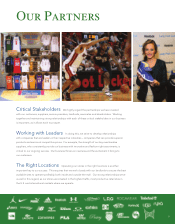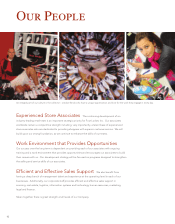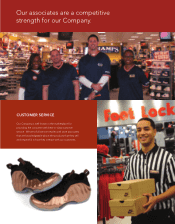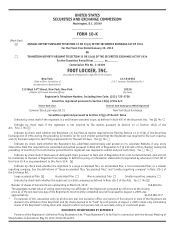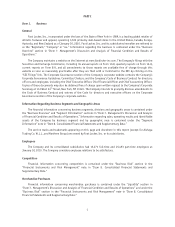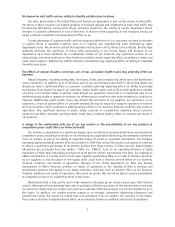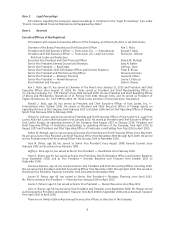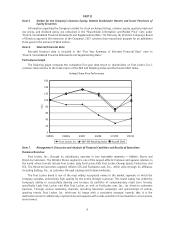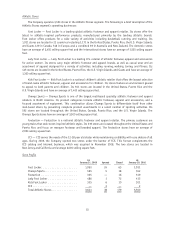Foot Locker 2009 Annual Report Download - page 21
Download and view the complete annual report
Please find page 21 of the 2009 Foot Locker annual report below. You can navigate through the pages in the report by either clicking on the pages listed below, or by using the keyword search tool below to find specific information within the annual report.We depend on mall traffic and our ability to identify suitable store locations.
Our sales, particularly in the United States and Canada, are dependent in part on the volume of mall traffic.
Our stores in these countries are located primarily in enclosed regional and neighborhood malls. Mall traffic may
be adversely affected by, among other things, economic downturns, the closing of anchor department stores,
changes in customer preferences or acts of terrorism. A decline in the popularity of mall shopping among our
target customers could have a material adverse effect on us.
To take advantage of customer traffic and the shopping preferences of our customers, we need to maintain
or acquire stores in desirable locations such as in regional and neighborhood malls anchored by major
department stores. We cannot be certain that desirable mall locations will continue to be available. Several large
landlords dominate the ownership of prime malls, particularly in the United States, and because of our
dependence upon these landlords for a substantial number of our locations, any significant erosion of our
relationships with these landlords or their financial condition would negatively affect our ability to obtain and
retain store locations. Additionally, further landlord consolidation may negatively affect our ability to negotiate
favorable lease terms.
The effects of natural disasters, terrorism, acts of war, and public health issues may adversely affect our
business.
Natural disasters, including earthquakes, hurricanes, floods, and tornados may affect store and distribution
center operations. In addition, acts of terrorism, acts of war, and military action both in the United States and
abroad can have a significant effect on economic conditions and may negatively affect our ability to purchase
merchandise from vendors for sale to our customers. Public health issues, such as flu or other pandemics, whether
occurring in the United States or abroad, could disrupt our operations and result in a significant part of our
workforce being unable to operate or maintain our infrastructure or perform other tasks necessary to conduct our
business. Additionally, public health issues may disrupt the operations of our suppliers, our operations, or our
customers, or have an adverse affect on customer demand. We may be required to suspend operations in some or
all of our locations, which could have a material adverse effect on our business, financial condition, and results of
operations. Any significant declines in public safety concerns or uncertainties regarding future economic
prospects that affect customer spending habits could have a material adverse effect on customer purchases of
our products.
A change in the relationship with any of our key vendors or the unavailability of our key products at
competitive prices could affect our financial health.
Our business is dependent to a significant degree upon our ability to purchase brand-name merchandise at
competitive prices, including the receipt of volume discounts, cooperative advertising, and markdown allowances
from our vendors, as well as our ability to negotiate returns of excess or unneeded merchandise. The Company
purchased approximately 82 percent of its merchandise in 2009 from its top five vendors and expects to continue
to obtain a significant percentage of its athletic product from these vendors in future periods. Approximately
68 percent was purchased from one vendor — Nike, Inc. (‘‘Nike’’). Each of our operating divisions is highly
dependent on Nike; they individually purchase 46 to 85 percent of their merchandise from Nike. Our inability to
obtain merchandise in a timely manner from major suppliers (particularly Nike) as a result of business decisions
by our suppliers or any disruption in the supply chain could have a material adverse effect on our business,
financial condition, and results of operations. Because of our strong dependence on Nike, any adverse
development in Nike’s financial condition or results of operations or the inability of Nike to develop and
manufacture products that appeal to our target customers could also have an adverse effect on our business,
financial condition, and results of operations. We cannot be certain that we will be able to acquire merchandise
at competitive prices or on competitive terms in the future.
Merchandise that is high profile and in high demand is allocated by our vendors based upon their internal
criteria. Although we have generally been able to purchase sufficient quantities of this merchandise in the past,
we cannot be certain that our vendors will continue to allocate sufficient amounts of such merchandise to us in
the future. In addition, our vendors provide support to us through cooperative advertising allowances and
promotional events. We cannot be certain that such assistance from our vendors will continue in the future.
These risks could have a material adverse effect on our business, financial condition, and results of operations.
3


